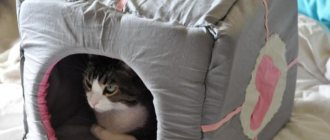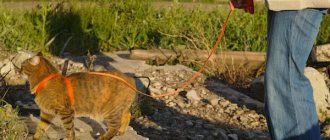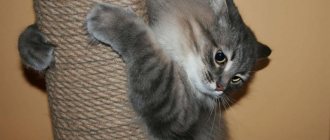Why is a blanket put on an animal after castration or sterilization surgery?
When castrating or sterilizing, a central or lateral incision is made on the animal’s abdomen, onto which, after the necessary manipulations, 3–5 stitches are applied. To avoid complications and to speed up wound healing, the operated cat is put on a postoperative blanket - this is a large fabric bandage equipped with several pairs of ties or Velcro that are fixed on the back. A blanket for a cat after sterilization is necessary for the following purposes:
- Protection against infection. Through a wound, pathogens can penetrate the skin and cause inflammation.
- Preventing animals from licking external agents used to treat sutures.
- Protection from scratching. Since the incision site is itchy, the cat can scratch it until it bleeds, and damaged skin is an open gate for infections.
- Preserving the integrity of the seams. Without a blanket, the animal can damage the threads holding the edges of the wound together, which will lead to the sutures coming apart.
- Preventing mechanical damage.
- Prevention of abdominal sagging due to weakening or stretching of the muscle walls.
Price for a postoperative blanket for a cat
You can now see the current price for blankets and buy them right here:
Blankets for cats after sterilization, ready-made, are sold everywhere. It's rare that you can't buy it. Both in a veterinary clinic and in any nearby pet store you can find this accessory at a fairly affordable price - about 100-150 rubles.
Recommendation: it is better to immediately buy two bandages or even more. After all, anything can happen after surgery.
- The bandage will become dirty with the preparations that need to be used to treat the seam.
- The cat may wet the material while going to the toilet.
Blankets in stores are not sold in universal sizes. Manufacturers usually take into account that cats come in different sizes. Therefore, on sale you can find blankets S, M, L. Sizes, like people’s: small, medium, large.
There is no need to take a blanket as if “for growth.” Despite the fact that it can be adjusted with ties, it is still better to measure the length of the torso first so as not to make a mistake.
There are usually blankets available with drawstrings that are long enough and can be adjusted depending on the size of your cat.
Dress for the sphinx
Using a simple pattern, you can make a beautiful dress for your hairless Sphynx cat. The most remarkable thing is that a dress of this kind can be made from just two pieces. First of all, the main part is made, and then the sundress, which is sewn to the base.
For your information! All this takes very little time, but looks very attractive. Do-it-yourself clothes for the sphinx, the patterns of which are presented in the picture below, can be made in a matter of hours.
Knitted suit on a Canadian cat
Pros and cons of clothing made from socks
Like any clothing, cat sweaters made from socks have a number of advantages and disadvantages. The main advantage is that the product is sewn quickly and easily. Even the lack of measurements is not a problem for creating such clothes. Another undoubted advantage is that everyone has warm terry socks, so in case of emergency it will not be difficult to get material for sewing. And, of course, another plus is the convenience and comfort of such a sweater for your pet.
As for the disadvantages, the main thing is the fragility of these clothes. But, considering that you can make clothes from a sock for a cat in just an hour, this drawback does not seem so significant. Another not-so-pleasant point is that such a jacket may not be suitable for large animals. In such cases, you can use your old sweater.
How much does a post-operative cat bandage cost, and how to tie it correctly?
The cost of a postoperative bandage for a cat is low. Depending on the type of fabric used, fixing materials and size, the price averages 100–200 rubles. (as of November 2019).
Sequence of actions for tying a bandage:
- The blanket is carefully applied to the cat's stomach and chest when it is standing or lying on its side. The smaller part should be between the head and front paws, the larger part should be pressed to the abdomen.
- The first pair of ties are fixed on the neck.
- The left ribbon of the second pair is connected to the right third, the other two are tied in pairs so that a cross of ribbons is formed at the withers.
- The fourth and fifth pair are tied at the back.
- The remaining ribbons are wrapped around the animal’s hips (they run horizontally) and secured.
How to make a blanket yourself?
Blankets are not always available for sale, and sometimes their cost seems too expensive. No problem: you can make a blanket for your cat with your own hands.
If you look at it, the product is not something complicated. This is one element to which the ties are attached. Of course, there is a certain system for these ties, so look at the photo of the cat blanket.
Before you make a cat blanket with your own hands, you need to decide on the size. They make a pattern: measure the circumference of the abdomen in centimeters, the length of the cat’s body - from the neck to the tail, since this is how the postoperative bandage will be located.
One of the bandage options. To sew a bandage yourself, you will need thick, clean fabric. Preferably cotton. But you can also make it from soft fabric, then it is best to take, for example, flannel.
Recommendation: if you decide to sew a blanket yourself, choose a thick, plain fabric that shows signs of dirt. If you see traces of blood, this should be a signal to visit your veterinarian immediately. Because this is a signal that the seams have come undone.
You should not choose material for blankets with unstitched areas. If even a small thread gets into the suture area, it can cause suppuration and inflammation.
Cut out a square piece, leaving a small allowance. Then, recesses are created in the square of material so that the animal’s paws can be inserted: both front and back.
Important: you need to leave a little material in front of the front paws so that after putting on the blanket it does not creep towards the stomach.
A ribbon or rope is sewn to each outer corner. It is better to choose tape because, unlike rope, it will not cut into the body and cause additional discomfort and pain to the animal. These elements are necessary as ties.
The ties should not be tightly secured. Check that you can fit 2 fingers between the blanket and the cat. Otherwise, the bandage may chafe, which will require additional assistance to the animal. And your pet will feel uncomfortable.
Sometimes, if you don’t have ordinary fabric at hand, and you need to make a blanket quickly, other available means are used. For example, unnecessary leggings or tights of sufficient density, a piece of a turtleneck sleeve or a trouser leg. Of course, it is important that this item is suitable for your cat, taking into account the length of her body. And you can make the holes for the front paws yourself. Fixation with a knot on the neck should not be too tight or pinch.
Sometimes it happens that the seam is made too low. Then such a bandage made from improvised materials can ride up, and there will be no particular use from it. In this case, it is worth cutting holes in the blanket for the hind limbs.
By the way, such a product will be easier to put on and take off, and you won’t have to worry about strings. And it will be more convenient for the animal. It will not constantly slide down, it will sit tightly on the body.
Terms of use
The animal's sutures must be periodically washed and treated during the postoperative period. In the process of performing such actions, the blanket does not need to be completely removed. Only the bottom pair of ribbons is untied. The product must adhere firmly to the cat.
If the bandage is dirty or has strong discharge, it is removed and replaced with a new one. Blankets should be changed regularly to minimize the risk of rotting and wound infection.
The product is completely removed only at the discretion of the veterinarian. If the blanket was made correctly and used correctly, it will ensure a quick recovery for the cat.
How to put on and take off a cat blanket correctly
A veterinarian must properly put the blanket on the cat after sterilization; in addition, he must instruct the animal owner on how to properly put on the bandage.
They put a special fabric bandage on the cat very carefully, while the cat is in a state of deep sleep.
This will allow the owner to practice a little in putting on the blanket correctly.
After sterilization, the cat’s blanket should not be tied tightly, so that two human fingers can fit freely between the bandage and the pet’s skin.
If the blanket is tied too tightly, there is a risk that it will rub against the cat, causing more discomfort.
The ties on the blanket must be secured firmly enough to prevent the animals from untying the knots. It is advisable to trim the ends of the ties so that the pet does not get caught on objects in the house or get stuck.
There is no need to completely remove the blanket from the cat after sterilization while processing the sutures.
Putting it back on will be quite problematic, especially in the first few days.
In order to have access to the wound surface for further antiseptic treatment, you can untie only the last ties and bend the edge of the blanket.
Animals become very tired from the post-operative bandage, so the cat may try to remove the blanket after sterilization.
But experts strongly recommend not allowing this to happen, in order to avoid infection of the wound surface and licking of the edges with sutures.
For maximum effectiveness, the cat's postoperative blanket is removed 3-4 days after the sutures are removed. It all depends on the degree of healing of the wound surface and the condition of the animal.
If the animal protests and flatly refuses to drink, eat, or go to the toilet with a blanket, then at this time you can remove the bandage, but you need to monitor the animal so that it does not start licking the wound.
How long should a cat wear a blanket and when should it be removed?
The length of time a cat wears a blanket after sterilization varies from person to person and ranges from 2 to 14 days. This depends on several factors:
- Type of wound treatment. If a protective spray is used, which minimizes the risk of inflammatory processes, the blanket is usually removed after a week.
- Seam material. External sutures made of non-absorbable thread are removed 7–12 days after sterilization. If self-absorbable materials are used and there is no inflammation, the bandage is worn for only 4–5 days.
- Localization of the seam. With a side incision, the wound size is smaller than with a middle incision, so it takes little time to heal.
- Type of surgical intervention. During laparoscopic surgery, only small punctures are made to insert instruments, so there is no need for sutures. Since there is no risk of seams coming apart, it is not necessary to wear a blanket. If it is worn, then only for 2-3 days.
- Seam condition. If no signs of inflammation are observed within 5–7 days, and the cat’s temperature and health are normal, the blanket is removed.
Early withdrawal
It happens that a cat removes the bandage on its own ahead of schedule. Most often this happens in the first 4 days after sterilization, since subsequently the pet gets used to it and behaves more calmly. Whether to return it to its place and whether the animal continues to walk with protection depends on the method of applying the suture material:
- If non-absorbable threads were used during sterilization, which will be removed 7 to 10 days after the operation, then the blanket must be immediately returned to its place.
- If absorbable threads were used and more than 4 days have passed since sterilization, and there is no oozing blood or lymph at the surgical site, or inflammation is not visible, then the cat no longer needs to wear a device to limit access to the wound.
Many owners allow their cat to walk without a bandage because they do not understand why there is such an urgent need. However, you need to know what the consequences of early withdrawal are:
- gnawing or licking of surgical thread and sutures coming apart;
- internal and external bleeding;
- microbes entering the wound;
- inflammation and rotting of the wound.
All these troubles can happen immediately, or they can happen within a few days after the animal is freed from the accessories that cause inconvenience. It is important to remember that if the owner allowed his cat to walk without a blanket, then he will no longer be able to make a claim or count on medical assistance under the guarantee that many veterinary clinics provide.
Sometimes the decision that a cat should stop wearing a brace is made by a veterinarian based on the following factors:
- the pet behaves aggressively, constantly trying to chew or pull off the blanket;
- the cat does not stand on its paws, is afraid to take even a few steps, stops eating;
- obvious signs of deterioration (nausea, vomiting, fever, lethargy);
- ulcers and abrasions in areas of maximum tissue pressure on the skin;
- heavily soiled blanket.
What types are there?
Some owners find it more convenient to use a product that is secured with Velcro.
The classic postoperative blanket is made of natural fabric, mostly cotton. The edges of the product are well processed so that the animal does not experience discomfort when wearing it. The bandage is a rectangular piece with cutouts for the paws; it is attached to the cat’s body with ties. If the laces are inconvenient to use for some reason, you can purchase a Velcro blanket. Another type of blanket is a stylish garment that is worn on a cat as decoration. This version of the product is also used during weaning of kittens from breastfeeding. The last variety is the protective blanket. It is necessary for short-haired cat breeds, such as Sphynxes, to protect against cold and hypothermia.
What else can you make for your pet?
In addition to blankets, decorative and warming things are often sewn for cats: tuxedos, skirts, light clothes for summer and thick ones for winter. Each requires the use of certain materials and entry-level sewing skills.
Cat skirt
The tuxedo
A stylish accessory that will highlight the elegance of a slender and long cat. This jacket is made according to a simple pattern, but it looks very beautiful, and most importantly, it does not hinder the movement of the animal. For production you will need:
- white fabric (old shirt);
- black fabric (any cut);
- some red cloth;
- Velcro for fixation;
- tailor's tools in the form of scissors, chalk, sewing machine or hand sewing accessories.
Costume for a British kitten
Airy skirt
If a tuxedo is more suitable for keeping warm, then a skirt is more suitable for going out. Usually these outfits are made for show animals, which appear before spectators and judges in original outfits. Skirts as clothing have become increasingly popular lately. The most important thing is that for manufacturing you will need a few materials and ordinary tools:
- a piece of tulle;
- satin ribbon;
- scissors, needle and thread.
You might be interested in everything about manual sewing machines for leather sewing
Important! This set is quite enough to make a beautiful skirt for a cat like a tutu without diagrams or patterns.
Pattern of a dress for a cat
Emergency heating
It happens that clothes for a pet are needed extremely urgently and there is not enough time to create patterns, transfer them to fabric and sewing. To quickly warm up, you can use a regular sock. For production you will need:
- one warm sock;
- scissors;
- chalk.
The idea is to make a vest out of a sock. It is very similar to a blanket, but does not require sterility. A tube is made from a sock with holes for the paws. After which it is put on the cat.
Warm sock
Summer minimalism
For the warm season there is no need for warm clothes, so things for summer are aimed at decorating the cat in a certain style. Such accessories can include ties, bow ties, hats and many others. So, to sew a bow tie you will need:
- collar;
- needle, thread and scissors;
- fabric for the butterfly.
How to sew a cat blanket with your own hands?
Ready-made blankets are inexpensive, but often you have to purchase not one, but several, because they often get dirty and become unusable, and this is already expensive. If you have time and desire, you can save money and make a bandage with your own hands. This is not difficult to do, and you only need a little material. If you sew the product in accordance with the measurements taken, it will fit your pet perfectly. This is especially true when its dimensions differ from standard ones.
What measurements will be needed?
To sew a blanket to fit the animal, you need to take measurements. To do this, you need to put the cat on its paws and measure the length of the body from the base of the neck to the tail, the girth of the chest and abdomen, the distance between the front and hind limbs. The measuring tape should not pull on the cat's body; it should pass quite freely, but without gaps.
How to take measurements from a cat
The main measurements to take are:
- neck girth. This is the circumference of the neck at its thickest and widest point. This is usually its base. To ensure an even measurement, it is necessary to place the animal on a flat surface;
- back length. The measurement is taken from the base of the neck to the beginning (root) of the ponytail. A centimeter placed along the spine is best suited for this;
- sternum girth. This measurement is taken around the widest part of the chest - under the front legs.
You might be interested in Patterns and DIY sewing of dresses in boho style
These measurements are enough for most products, but sometimes additional data is needed. For example, the distance between the paws.
Cat measurements
Options from improvised means
You can make a blanket from scrap materials, such as tights and socks.
A pantyhose bandage must be made from tights with good density. You can also use trouser legs and sleeves from already unnecessary clothes. Holes for the paws are made in such blanks. After use, such products do not need to be washed, but simply thrown away.
Sock blankets are suitable for kittens and teenage animals, since only they can fit into products of this size. Only a new, never used sock is suitable for production. Slots are made in it for the paws. The hole from the heel should be in the pet's groin. A cord can be used as a tie. This version of the bandage is not very reliable, since the animal can easily take it off.
Using tights, socks and other clothing to make blankets is a simple solution, but the material itself is not very suitable for performing the tasks assigned to the product. Therefore, it is better to sew a bandage from scratch from a more suitable material.
Blanket for cats from improvised means
There are benefits to making a homemade product beyond the savings.
Why do you sew protection yourself:
- This is an opportunity to make a cat bandage that fits properly.
- You can sew spare options for replacement in case of damage.
Be sure to read:
A cat sleeps a lot and is lethargic after sterilization: normal or pathological, what consequences may occur after the operation
DIY options:
- Make from ready-made products: use tights, socks, old children's clothes.
- Sew them with suitable fabric yourself.
Wearing postoperative clothing continues for the entire period recommended by the veterinarian. On the 3-4th day the animal begins to try to remove the protection.
Pantyhose blanket
The bandage is made from thick tights. To do this, cut off the top and bottom parts, leaving 20 centimeters of fabric.
Requirements:
- For the bandage, use clean tights to protect the seam from dirt.
- Choose new products from dense material.
A homemade bandage has disadvantages:
- Putting on a “sleeve” of tights is difficult and sometimes dangerous. It’s easy to strengthen a classic blanket with ribbons.
- The front side often rolls down and does not stick to the body.
- A cat easily damages fabric with its claws.
- For kittens, homemade protection from tights is not suitable due to its large size.
The advantage of the idea is savings and ease of implementation.
Sock blankets without ties
Access to the seam will be limited by a sock with a cut-off side in the form of a pipe.
Advantage of socks:
- It's easy to change the bandage daily without having to wash it.
- Available in many sizes to suit different pets.
- One edge of the product with an elastic band additionally strengthens the fabric on the animal's body.
Socks are not recommended for active animals.
Important! Socks are often made from low-quality materials; it is important to check the composition of the fabric.
Blanket from old children's clothes
The option with old children's pet clothes is similar to the ideas with socks and tights. For postoperative clothing, take undershirts and shirts. The excess parts are cut off and used for a new purpose. Shirt sleeves are used as tights, cutting off the edges.
Advantages:
- Children's clothes are made from soft, natural fabrics.
- The presence of buttons and bandages on the vests simplifies the process of putting it on your pet.
The disadvantage is that it is difficult to find clothes that fit in size for a kitten or an adult pet of small stature.
Be sure to read:
How long does it take for a cat to recover from anesthesia after castration: the condition immediately after surgery, which should alert you
What to do if a cat pulls off its blanket?
On average, it takes 7 to 10 days to wear the bandage. What to do if the cat pulls off the blanket even though the deadline has not yet expired? There is nothing surprising in the fact that the animal is trying to get rid of the bandage, because it is not used to having something on its body. The pain of the stitches also makes you want to get to the problem area. Obviously, wearing a bandage causes discomfort for your pet, but this is not a reason to get rid of it until the wound heals.
To prevent the bandage from being removed, you can temporarily place your cat in a carrier or basket. A pet with limited mobility will not be able to pull off the blanket. If the cat managed to remove it, you need to fix the product again, following the instructions - perhaps the bandage was tied incorrectly or too loosely the first time. Before doing this, you should check the condition of the stitches for any bleeding, bumps, inflammation or suppuration that could cause pain to the cat.
If your pet does not allow you to put on a bandage or constantly gets rid of it, you need to use an Elizabethan collar. This design limits head movement and prevents the cat from removing the blanket.
If continuous frantic attempts to get rid of the blanket are accompanied by symptoms such as refusal of food and water, aggressive behavior, breathing problems, vomiting, tremors, fever, you should consult a veterinarian. These signs may indicate complications. If they are absent, but the pet is overly anxious, the doctor may prescribe sedatives.
Share with friends!
Sewing blankets from improvised materials
Below we will describe how and from what you can make a blanket if you don’t have any suitable material or patterns at hand. You don't need any special cutting and sewing skills.
You might be interested in Description of bias tape: how to make it yourself
Scheme of overalls for a cat
Pantyhose blanket
The simplest option, which requires virtually no resources. There is only one rule: you need to use clean tights, since the animal definitely needs sterility after surgery and sterilization. It is recommended to use thick tights that will fit the cat's body well.
Important! The blanket is made like this: a piece of trouser leg 20 cm long is cut off and pulled over the cat’s belly. Additionally, you can make holes for the paws.
New Year's suit for the British
Sock blankets without ties
The product is made from socks or stockings in the same way. Find the perfect size sock and cut off the front to create a fabric tube. The cat's body is inserted into it, fixing its stomach.
For your information! The most remarkable thing is that even if you don’t have the appropriate sizes at home, you can always buy clean and new socks at any clothing store for a few tens of rubles.
Cat blanket from a baby bodysuit
Blanket from old children's clothes
Old children's clothing in the form of jumpsuits and vests also works well. You should choose something that fits comfortably on your body and is fixed on it. If you don’t have anything like this at hand, then you can make a blanket from an ordinary sleeve of a children’s jacket that stretches well.
Fashionable outfit with a hood
Towel blankets
The most common option involves making it from a simple cotton towel. A cut of the required length is made, and holes for the paws are cut out, based on the anatomical features of the cat. Holes are cut in it for the neck, paws and sometimes the tail. The final stage involves creating a cylinder by sewing the ends of the towel together or sewing on strings.
If the cat is to be sterilized, then you need to buy a blanket
Observation after removal of the bandage
After the bandage is removed, it is necessary to carefully monitor the cat's condition in the first days. The cat family is characterized by increased cleanliness, therefore, at first the animal will constantly lick the seam.
The owner must ensure that the cat does not chew the edges of the healed wound.
Be sure to read:
Complications after castration of a cat: causes, types, symptoms and treatment, when you need to see a doctor
Important points during inspection:
- monitor the integrity of the edges of the wound surface;
- control whether there is any discharge from the wound in the form of blood or lymph;
- inspect the seam for redness, inflammation, and the appearance of purulent discharge;
- check whether nodes or swellings have appeared along the edges of the wound surface.
Any of the identified anomalies is a reason for an unscheduled visit to the veterinarian.
Instructions for putting on
Most often, the blanket is secured to the animal’s body using regular ties. Velcro versions are available for sale. Dressing a cat in such a bandage is much easier, but blankets with Velcro are more expensive.
The first putting on of the blanket occurs immediately after the operation. Most often at this time the animal is still under anesthesia or only partially conscious. In this state, the cat does not offer resistance, which greatly simplifies the process. You should be very careful and careful, do not make sudden movements when manipulating the animal’s body: fresh seams can be damaged very easily.
In the future, you will have to repeatedly treat the wounds and put a bandage on an already active animal. It is important to act as calmly as possible. If a cat is nervous and resists, talk kindly to your pet and pet it. Spread the bandage on the table and place the cat on top of it, tummy down.
It will be better if someone helps you the first time - it is much easier to carry out this process together.
Let one person calm and stroke the animal, and in the meantime you can carefully and slowly tie the laces of the bandage according to the pattern.
DIY blanket
If you want to sew a blanket for your pet yourself, you won’t have any difficulties. It’s easy to sew, and you can always find detailed diagrams and patterns on the Internet. It is best to select fabric for the bandage from your old things. The cat, feeling a familiar smell from the fabric, will feel much more confident and calm.
To make a postoperative bandage you will need:
- chintz or calico;
- ribbons;
- tools for work: pins, needles, threads, scissors, pencils and a ruler.
The dimensions of the pet are taken with a tailor's centimeter. Measurements needed to model the pattern:
- chest girth;
- length from withers to beginning of tail;
- peritoneal girth;
- the distance between the front and hind legs.
When cutting out parts, do not forget about an allowance of 0.5 cm. Before you start sewing, if you bought new fabric, be sure to wash it so that it shrinks.
Having cut out the parts, sew them together, machine the edges, and sew on fixing ropes. If desired, replace the rope with a zipper.
When preparing for surgery, prepare several blankets for each shift in advance to ensure your cat feels comfortable.
Purpose of the product
A blanket is placed over your pet's belly to protect the belly after surgery. Thanks to this cover, the surgical site is not affected by pathogenic microflora, and the animal will not be able to scratch and lick the wound. So the cat reflexively tries to speed up the healing process, but in reality this only leads to irritation. Along with her saliva, germs and viruses can enter the wound.
The product is tied tightly. It pulls the edges of the wound together, making regeneration faster. The body will have to spend less energy on tissue restoration.
A correctly applied blanket prevents the abdominal muscles from weakening and stretching . Therefore, a sterilized cat’s belly will not sag.
Medicines: analgesics, suture antiseptics, antibiotics, vitamins
Analgesics will need to be given for the first 2 days. The fact that the postoperative wound hurts is indicated by a change in the animal’s behavior. The cat shows aggression, meows, and refuses to move.
Analgesics will be required for the first 2 days.
Doctors recommend using painkillers:
- Ketoprofen (1% solution). The injection is given subcutaneously or intramuscularly once a day. The dose is calculated at 0.2 ml per kg of weight. Inject no more than 4 times.
- Tolfedine (tablets). Given with food. Dosage: 4 mg per kg.
- Meloxicam (suspension). On the first day, give 0.1 mg/kg, and in subsequent days, reduce the dose by half and give 0.05 mg/kg.
To treat sutures, veterinarians advise using:
- chlorhexidine 0.05%;
- Dioxidin 0.5%;
- Chemi spray;
- Vetericin spray.
During the recovery period after sterilization, antibacterial drugs are not prescribed. Antibiotics may be required if postoperative complications occur and an inflammatory process is detected.
For treatment use:
- Amoxicillin 15%. 1 ml/kg once a day for 5 days subcutaneously or intramuscularly.
- Sinulox. 0.5 ml/kg intramuscularly for 3-5 days.
Vitamins and restoratives are given only to old or weakened individuals. Gamavit is prescribed at 0.05 ml/kg for the first 3 days, and then the dose is increased to 0.1 mg/kg and given for 2 weeks.











